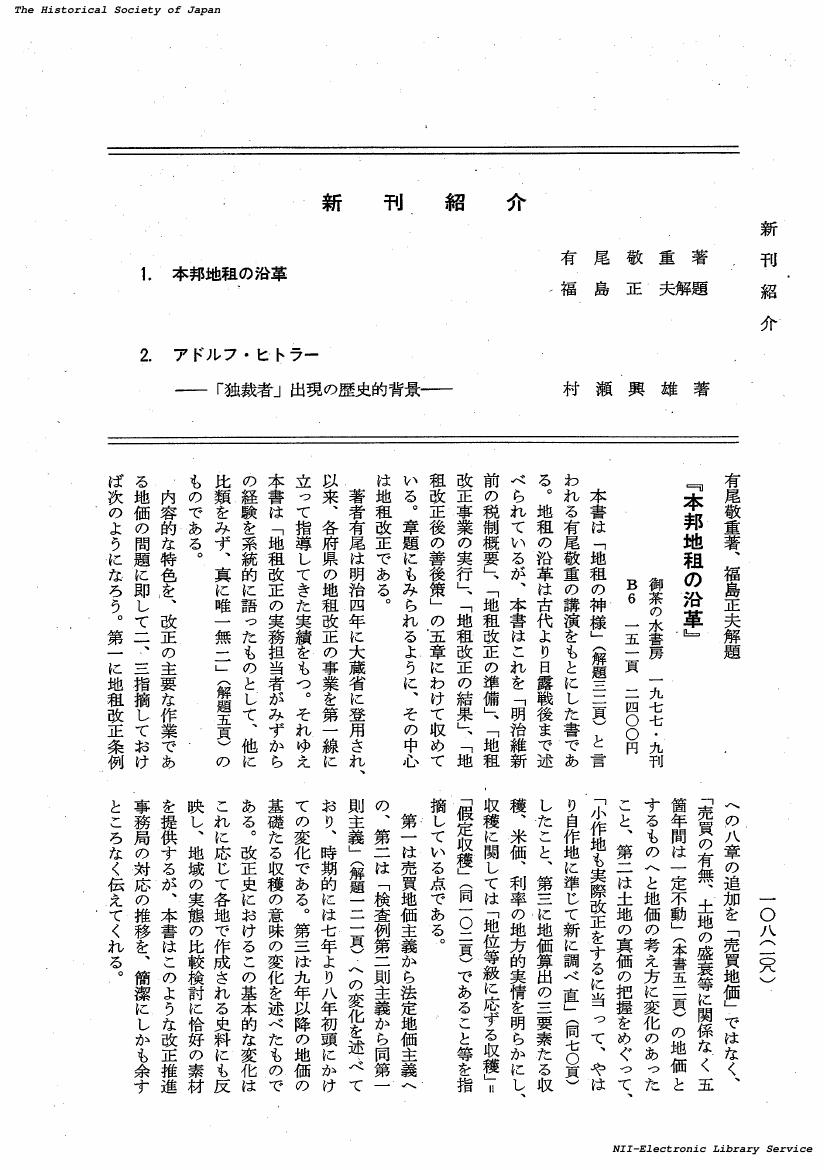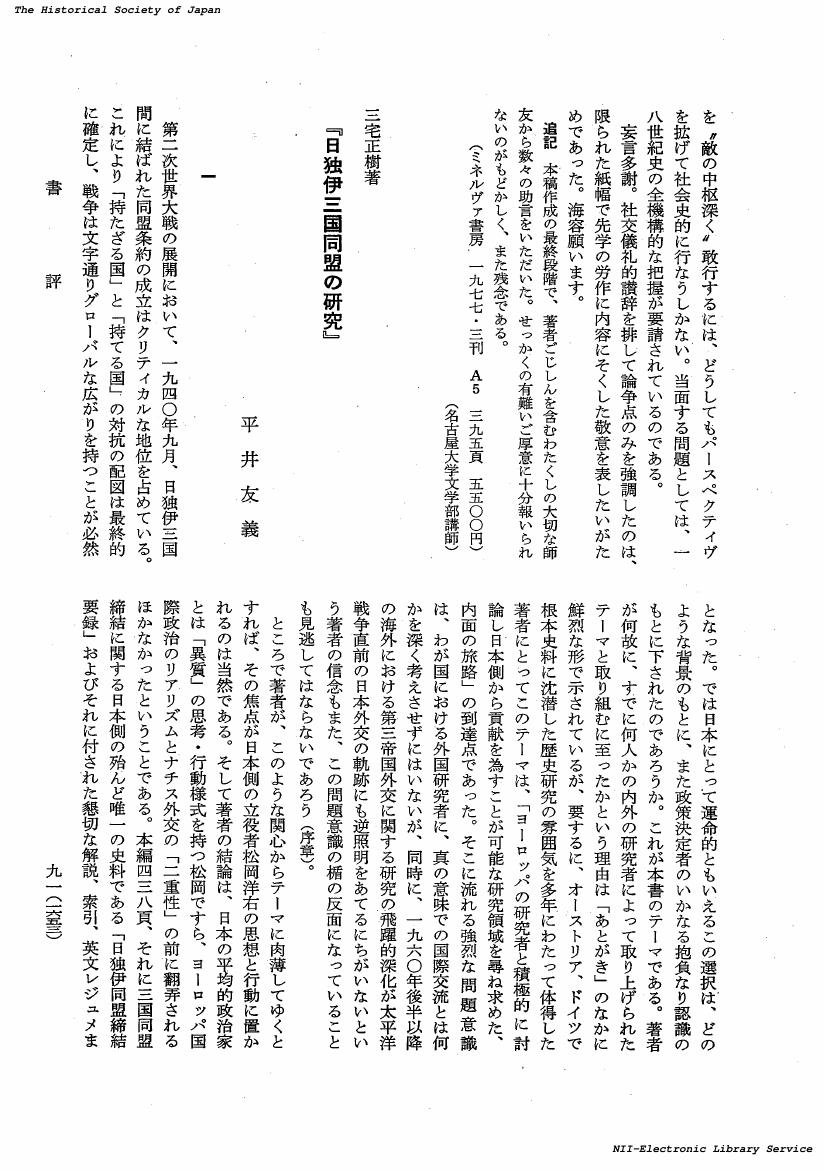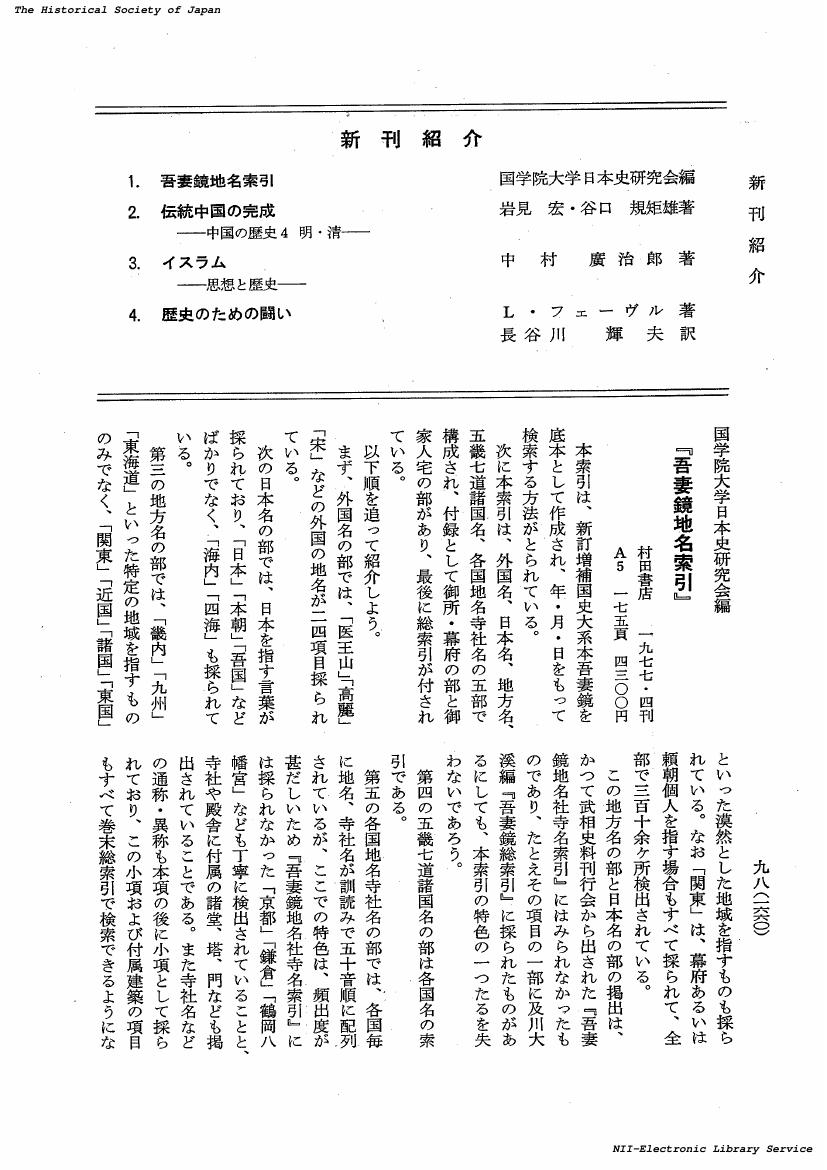1 0 0 0 OA 戦国期における在地法秩序の考察 : 甲賀郡中惣を素材として
- 著者
- 宮島 敬一
- 出版者
- 公益財団法人 史学会
- 雑誌
- 史学雑誌 (ISSN:00182478)
- 巻号頁・発行日
- vol.87, no.1, pp.1-43,138-137, 1978-01-20 (Released:2017-10-05)
This article considers the aspects of the local law system which was newly built up in the Sengoku period. In the Sengoku period the conflicts of medieval society developed and the elements forming early modern society appeared. To grasp this historical sequence, this article focuses its attention on the local magnates and landlord (dogo 土豪, jizamurai 地侍), that is, immature lords, in whom the conflicts of late medieval society were embodied, instead of adopting the traditional way of concentrating on sengoku-daimyo lords (戦国大名). The local law system with which this article deals contains a certain way of mediation and arbitration conducted independently in a particular area or region to settle a quarrel and a dispute, the aspects of the legal entity -individuals, institutions and organizations in charge of the arbitration, the norm and logic upon which they were founded, and so on. The material is drawn from Koga Gunchuso the subject of many previous studies. Chapter 1 of this article, based on the study of local economic conditions, considers the characteristics of local magnates and landlord who took the lead in building up the local law system ; their organizations, that is, the group of families with the same surname (domyochu 同名中) ; and the group of persons of lower status (wakato 若党). Chapter 2 considers the family group of the same surname and the rules of the 'three family groups' (sanpo 三方), which means considering the contents of the local law ; Chapter 3 the procedure and examination process of the local trial, and Chapter 4 the details of the local disputes and their arbitration awards. By considering these points, the author comes to the following conclusions. Each of the local magnates and warriors was not a lord ruling the whole of a territory, but a kind of landowner who collected an additional rent (kajishi-tokubun 加地子得分). These magnates conflicted with one another and with the peasants who paid it. In spite of this fact the system of local trial and law which the local magnates and landlord built up on an 'equal' footing was well maintained both institutionally and substantially. It was shown in (1)adequate and impartial examination and arbitration, (2)the original appropriateness of the arbitration, (3)establishment of the laws and rules, and (4)the institutions, organizations and status order which kept them. It was also shown in (5)the fact that this local law system arbitrated all the local quarrels and disputes compulsorily. Therefore this system of trial and law is regarded as one of a regional power, an establishment which had the two functions of protecting or controlling the class interest of local magnates and landlord and of ruling the village in the face of the peasantry through adaptation to new economic circumstances. This legal rule and law system of the immature lords had a great significance in the establishment of a national government and the formation of early modern society, because it seems to have been widespread in the kinai-kingoku area (畿内近国) and it resembled the rule of early modern society. It can be guessed that a national government and early modern society were realized by the 'aufheben' of such a local law system.
1 0 0 0 OA 日朝貿易における白糸・絹織物の輸入と京都販売
- 著者
- 田代 和生
- 出版者
- 公益財団法人 史学会
- 雑誌
- 史学雑誌 (ISSN:00182478)
- 巻号頁・発行日
- vol.87, no.1, pp.44-67,137-136, 1978-01-20 (Released:2017-10-05)
It has often been said that white raw silk and fabrics were imported into Tokugawa Japan only through Nagasaki. However, this opinion overlooks the silk imports that came into Japan, with government authorization, through Tsushima-han. Such silk and silk fabrics were originally made in China but transmitted to Japan by Korean merchants. The quantity of this trade was fairly large by the late seventeenth century, and sometimes it even exceeded that of the Nagasaki silk trade. The price of silk and silk fabrics imported to Japan through Korea was generally lower than similar goods coming in through Nagasaki. The silk and silken fabrics were brought to the central market town, Kyoto, and sold from Tsushima-han to two wholesale merchants, Chosen-donya 朝鮮問屋 and Fukaeya 深江屋 who was financed by the great merchant Mitsui 三井 (Echigoya 越後屋). This marketing occurred completely independently of the Nagasaki route. At the same time it is important to note that the silver ingot called Chogin originated in Kyoto, and also was the main export good from Tsushima-han to Korea. This silver eventually flowed onto China. Thus, an international silk and silver trade between Japan and China via Tsushima and Korea was established in Tokugawa Japan with Kyoto functioning as the entrepot at the Japanese end of this route. Many problems and even facts of the marketing of imported goods in Tokugawa Japan have been ignored for a long time by historians. By studying a major component of this neglected trade, the Korean trade of Chinese silk, the author has tried to clarify the developments and market structure of this trade.
1 0 0 0 OA 辛島昇編『インド史における村落共同体の研究』
- 著者
- 長崎 暢子
- 出版者
- 公益財団法人 史学会
- 雑誌
- 史学雑誌 (ISSN:00182478)
- 巻号頁・発行日
- vol.87, no.1, pp.96-102, 1978-01-20 (Released:2017-10-05)
- 著者
- 渡辺 隆喜
- 出版者
- 公益財団法人 史学会
- 雑誌
- 史学雑誌 (ISSN:00182478)
- 巻号頁・発行日
- vol.87, no.1, pp.108-109, 1978-01-20 (Released:2017-10-05)
- 著者
- 志垣 嘉夫
- 出版者
- 公益財団法人 史学会
- 雑誌
- 史学雑誌 (ISSN:00182478)
- 巻号頁・発行日
- vol.86, no.11, pp.1663-1664, 1977-11-20 (Released:2017-10-05)
1 0 0 0 OA 「ネップ」初期研究 : 「商品交換体制」の成立をめぐって
- 著者
- 石井 規衛
- 出版者
- 公益財団法人 史学会
- 雑誌
- 史学雑誌 (ISSN:00182478)
- 巻号頁・発行日
- vol.86, no.12, pp.1691-1734,1817, 1977-12-20 (Released:2017-10-05)
1 0 0 0 OA 佐脇栄智著『後北条氏の基礎研究』
- 著者
- 池上 裕子
- 出版者
- 公益財団法人 史学会
- 雑誌
- 史学雑誌 (ISSN:00182478)
- 巻号頁・発行日
- vol.86, no.12, pp.1735-1741, 1977-12-20 (Released:2017-10-05)
1 0 0 0 OA 仲手川良雄著『ブルクハルト史学と現代』
- 著者
- 坂井 直芳
- 出版者
- 公益財団法人 史学会
- 雑誌
- 史学雑誌 (ISSN:00182478)
- 巻号頁・発行日
- vol.86, no.12, pp.1755-1764, 1977-12-20 (Released:2017-10-05)
1 0 0 0 OA 小坂 博之著『山名常〓と禅刹』, 楞厳寺, 一九七六・九刊, A5, 二三〇頁
- 著者
- 田中 博美
- 出版者
- 公益財団法人 史学会
- 雑誌
- 史学雑誌 (ISSN:00182478)
- 巻号頁・発行日
- vol.86, no.12, pp.1788-1790, 1977-12-20 (Released:2017-10-05)
- 著者
- 内河 久平
- 出版者
- 公益財団法人 史学会
- 雑誌
- 史学雑誌 (ISSN:00182478)
- 巻号頁・発行日
- vol.86, no.12, pp.1790-1791, 1977-12-20 (Released:2017-10-05)
1 0 0 0 OA 庄内藩の寛政改革と農村構造
- 著者
- 吉村 仁作
- 出版者
- 公益財団法人 史学会
- 雑誌
- 史学雑誌 (ISSN:00182478)
- 巻号頁・発行日
- vol.86, no.11, pp.1563-1596,1690-, 1977-11-20 (Released:2017-10-05)
This article is intended to examine the basic agrarian policy executed in the end of the 18th century and the early part of the 19th century in the Shonai clan, and through it to throw light upon the characteristics of the social structure of the rural community at the period. The Shonai clan at that period, especially in the end of the 18th century when the Kansei Reform was started, saw the devastation of the rural community so terrible that an expression of a "structural crisis" is given to it. The devastation was concretely shown in the collapse of agriculture management under the severe exploitation, the joint management by the village community of the lands whose occupiers ran off, the exploitation by the usurious capital, the yoke of the organization for tax collection, the accumulation of land by landowners, and so on. The clan confronted with those problems tried to restore the village community by the adjustment of the government organization, the reorganization of the mercantile and usurious capitalists, the policy of land redemption, that is the one of settling occupiers on their lands, and so forth. The social structure of the village community at that period was characterized by the joint operation of deserted lands according to the village customs (mura-sozukuri) and the landowner-tenant relations through the village community. Both were the two manifestations or ways of the same conflict in the village social structure. The policy of settling occupiers on their lands was the basic policy adopted in the reform for maintaining the system of the peasant proper (hon-byakusho). The policy was intended to meet the conflict in the village, but at the same time it could not help being restricted by the village customs. The peasantry had "struggles" by relying upon the customs, and this was the basic form of class conflict at this period. Therefore, however, the decisive aggravation of class conflict waited till the closing years of the Bakufu and the Restoration period when the village community began to gravely disintegrate and reorganize itself. And the trend of poor peasants with various forms of existence in landowner-tenant relations can be used as an index of the aggravation of class conflict.
1 0 0 0 OA 細川行信著『真宗成立史の研究』
- 著者
- 重松 明久
- 出版者
- 公益財団法人 史学会
- 雑誌
- 史学雑誌 (ISSN:00182478)
- 巻号頁・発行日
- vol.86, no.11, pp.1629-1638, 1977-11-20 (Released:2017-10-05)
1 0 0 0 OA 森田 明著『清代水利史研究』
- 著者
- 濱島 敦俊
- 出版者
- 公益財団法人 史学会
- 雑誌
- 史学雑誌 (ISSN:00182478)
- 巻号頁・発行日
- vol.86, no.11, pp.1638-1646, 1977-11-20 (Released:2017-10-05)
1 0 0 0 OA 岸田 紀著『ジョン・ウェズリ研究』
- 著者
- 近藤 和彦
- 出版者
- 公益財団法人 史学会
- 雑誌
- 史学雑誌 (ISSN:00182478)
- 巻号頁・発行日
- vol.86, no.11, pp.1646-1653, 1977-11-20 (Released:2017-10-05)
1 0 0 0 OA 三宅正樹著『日独伊三国同盟の研究』
- 著者
- 平井 友義
- 出版者
- 公益財団法人 史学会
- 雑誌
- 史学雑誌 (ISSN:00182478)
- 巻号頁・発行日
- vol.86, no.11, pp.1653-1659, 1977-11-20 (Released:2017-10-05)
- 著者
- 山本 博也
- 出版者
- 公益財団法人 史学会
- 雑誌
- 史学雑誌 (ISSN:00182478)
- 巻号頁・発行日
- vol.86, no.11, pp.1660-1661, 1977-11-20 (Released:2017-10-05)
- 著者
- 山名 弘史
- 出版者
- 公益財団法人 史学会
- 雑誌
- 史学雑誌 (ISSN:00182478)
- 巻号頁・発行日
- vol.86, no.11, pp.1661-1662, 1977-11-20 (Released:2017-10-05)
- 著者
- 安藤 正人
- 出版者
- 公益財団法人 史学会
- 雑誌
- 史学雑誌 (ISSN:00182478)
- 巻号頁・発行日
- vol.86, no.10, pp.1533-1534, 1977-10-20 (Released:2017-10-05)
1 0 0 0 OA 後藤 靖編『天皇制と民衆』, 東大出版会, 一九七六・一〇刊, 四六判, 二〇七頁
- 著者
- 宮地 正人
- 出版者
- 公益財団法人 史学会
- 雑誌
- 史学雑誌 (ISSN:00182478)
- 巻号頁・発行日
- vol.86, no.10, pp.1534-1535, 1977-10-20 (Released:2017-10-05)
1 0 0 0 OA 矢島祐利著『アラビア科学史序説』, 岩波書店, 一九七七・三刊, B6, 四四五頁
- 著者
- 田中 一郎
- 出版者
- 公益財団法人 史学会
- 雑誌
- 史学雑誌 (ISSN:00182478)
- 巻号頁・発行日
- vol.86, no.10, pp.1536, 1977-10-20 (Released:2017-10-05)
















